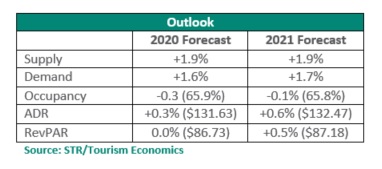LOS ANGELES—For the first time since 2009, the U.S. hotel industry is projected for a non-growth year in revenue per available room (RevPAR), according to STR and Tourism Economics’ first forecast of 2020 just released at The Americas Lodging Investment Summit (ALIS).
“2019 was the industry’s worst year since the recession for RevPAR growth, which came in at an uninspiring 0.9% after nine years of increases of basically 3% or higher,” said Amanda Hite, STR’s president. “The good news, of course, was the fact that we saw another record year for demand and still saw RevPAR growth on top of an all-time high level. We’re projecting for that growth to further decelerate this year before a bit of an uptick in 2021.”
The previous version of the U.S. hotel forecast released in November called for RevPAR increases of 0.5% in 2020 and 0.7% in 2021. With occupancy comparisons moving into negative territory, average daily rate (ADR) is the sole driver of growth in RevPAR, the industry standard performance metric.

“Concern continues around ADR, which has grown below the level of inflation for six straight quarters,” Hite said. “With hoteliers adapting to flat-to-negative pricing expectations, we downgraded our ADR projections 60 basis points.
“As has been the case, demand will still be there even with slightly weaker growth. The economic outlook remains steady as well with some risk reduction around trade, fiscal and monetary policies.”
All chain scale segments are likely to report occupancy decreases in 2020, the worst of which coming from Upscale properties (-0.9%). Luxury chains are projected to post the largest gains in ADR (+1.2%) and RevPAR (+0.9%).
In 2021, the Independent segment is projected to have flat occupancy while all others segments are expected to show decreases in the metric. Independents are also forecasted for the highest jump in RevPAR (+1.0%) in 2021, and Luxury chains are once again expected to post the highest ADR growth of 1.3%.
“Supply growth has been manageable when you look at the total numbers, but there has been a disproportionate amount of new inventory entering the limited-service marketplace,” Hite said. “While demand continues to be healthy in those segments, the jump in supply is going to put more pressure on performance levels.”
A note to editors: All references to STR data and analysis should cite “STR” as the source. Please refrain from citing “STR, Inc.” “Smith Travel Research” or “STR Global” in sourcing as those names no longer fit within the STR brand.
About STR
STR provides premium data benchmarking, analytics and marketplace insights for global hospitality sectors. Founded in 1985, STR maintains a presence in 15 countries with a corporate North American headquarters in Hendersonville, Tennessee, an international headquarters in London, and an Asia Pacific headquarters in Singapore. STR was acquired in October 2019 by CoStar Group, Inc. (NASDAQ: CSGP), the leading provider of commercial real estate information, analytics and online marketplaces. For more information, please visit str.com and costargroup.com.
About Tourism Economics
Tourism Economics, an Oxford Economics company, focuses on the intersection of the economy and travel sector, providing actionable insights to our clients. We provide our worldwide client base with direct access to the most comprehensive set of historic and forecast travel data available. And our team of specialist economists develops custom economic impact studies, policy analysis, and forecast models.
Media Contacts:
Nick Minerd
Senior Director, Communications
nminerd@str.com
+1 (615) 824-8664 ext. 3305
Aran Ryan
Director, Lodging Analytics
aran.ryan@oxfordeconomics.com
+1 610 995 9600
0 Comments